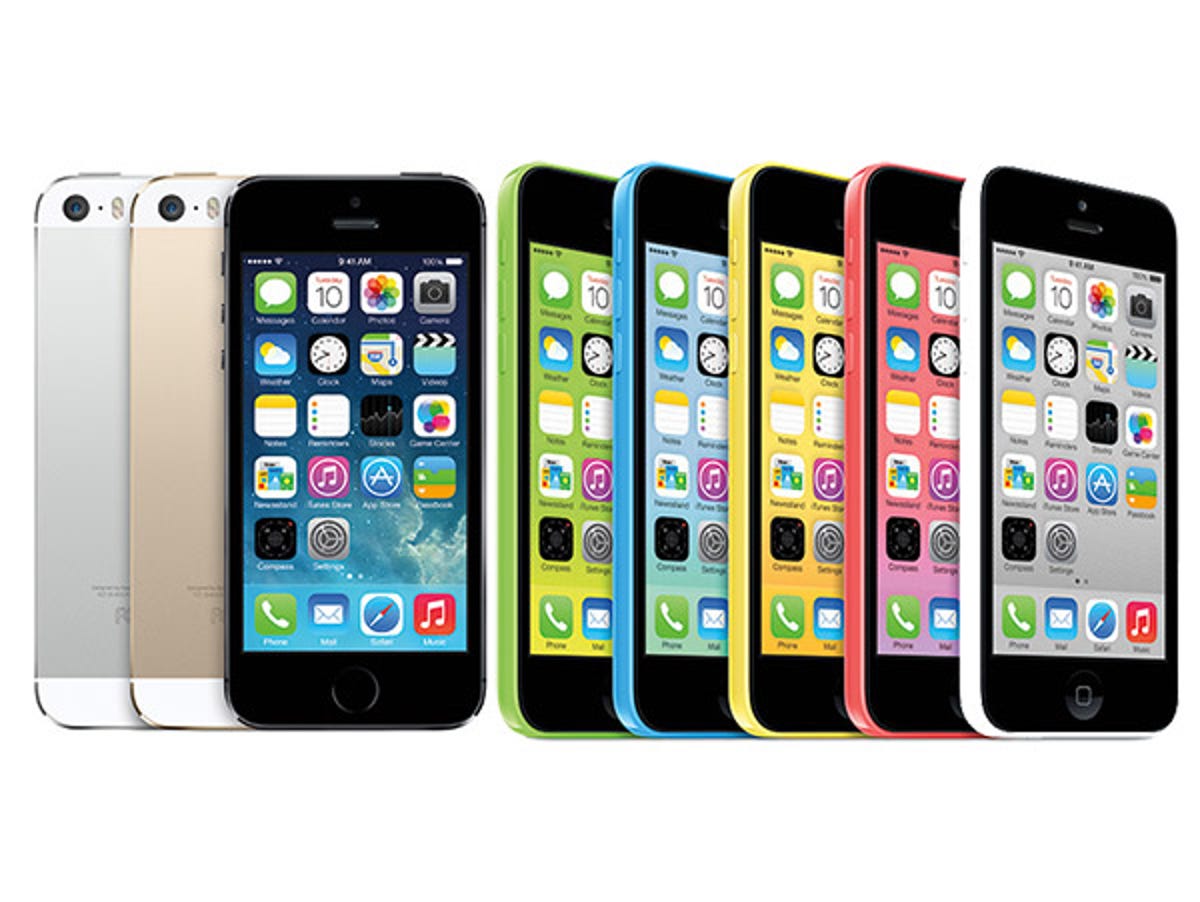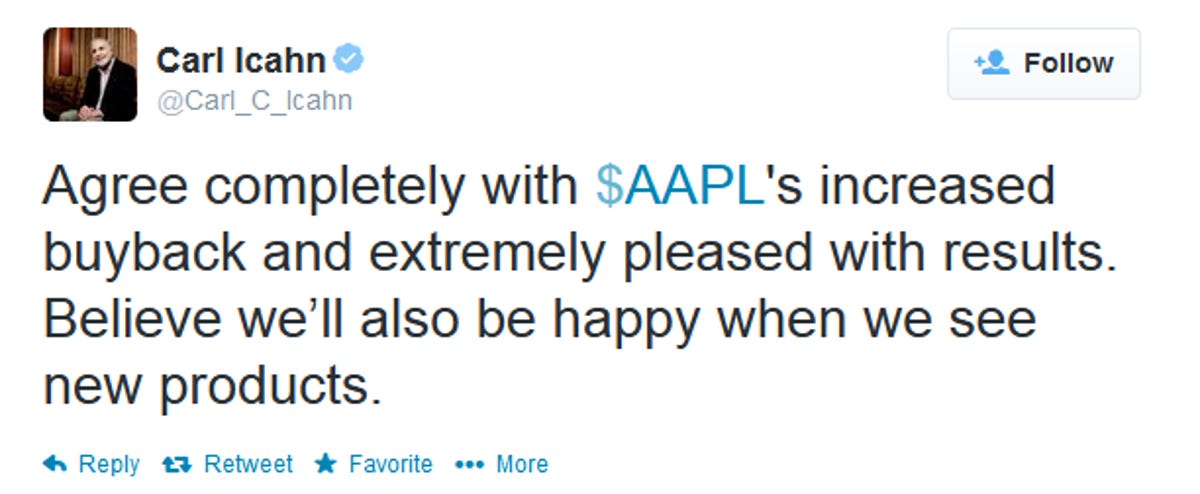
James Martin/CNET
Apple on Wednesday posted better-than-expected quarterly results, said it would return more cash to shareholders, and announced a 7-for-1 stock split.
“Our underlying business performance was even stronger than our reported results imply,” Chief Executive Tim Cook said during a conference call with analysts.
The Cupertino, Calif., tech giant said it sold 43.7 million iPhones, much higher than the expected 38 million and a record for the March quarter. The company also reported a surprise return to earnings growth — its highest rate in the past six quarters — and better revenue and gross margins than analysts and Apple had anticipated. That the iPhone — Apple’s biggest moneymaker — accounted for much of the growth came as a relief to investors who worried that demand was waning ahead of the iPhone 6 later this year.
Cook noted that the strong iPhone sales “were broad-based, both from a product point of view, with demand for each of our three iPhones stronger than its predecessor, and from a geographic standpoint.”
As if that weren’t enough to please investors, Apple also boosted the amount of cash that it’s returning to shareholders by about $30 billion to more than $130 billion and said it would split shares to make its stock more accessible to investors.
The news — which helped assuage some recent fears about the company — sent shares jumping 8.1 percent to $568.76 in after-hours trading. Shares initially were halted ahead of the news.
“The humongous buyback and increased dividend will satisfy many of the critics asking to share in the cash pile,” Michael Obuchowski, Apple shareholder and chief investment officer of Merlin Asset Management, told CNET. “The 7:1 split is likely to attract small retail investors, making [the] stock more accessible. Basically the company is seemingly doing everything to appease investors and critics — except for introducing new products that could give us visibility for Apple’s future for the next several years instead of just the next few quarters.”
See also
- Apple v. Samsung: All you need to know about latest patent trial (FAQ)
- Samsung drops iPad infringement claims, asks for less money
- Apple’s higher standard: How 51M iPhones is somehow disappointing
The results come as Apple battles Samsung in a patent-infringement trial in San Jose, Calif. They also come as Apple faces more questions about its momentum and future. The pressure has been on for the company to enter new product categories — such as smart TVs and wearables — instead of incrementally updating its existing devices.
Apple’s results have been fueled by the iPhone for the past several years, but the company is facing more competition than ever before. Samsung and others are pressuring the company at the high end, while Apple is largely missing out on the low end of the market. That’s a big concern as more and more mobile sales come from emerging markets like China, where inexpensive phones from companies such as Huawei and ZTE are popular. It also faces changes in smartphone upgrade policies and a push by carriers to sell full-price devices.
Apple earlier this year started selling the iPhone through China Mobile, the world’s biggest wireless carrier. And in September, it introduced two new versions of the iPhone for the first time ever, including the less-expensive but more colorful iPhone 5C. Apple also rolled out the new iPad Air and iPad Mini with Retina Display the following month. The company hoped the new products would keep the momentum going, despite ongoing concerns that the iPhone 5C isn’t selling well and that China Mobile demand may be sluggish.
Another worry has also plagued Apple of late — that consumers are holding off on buying the current, 4-inch iPhone models in hopes a new version will hit the market soon. The company is believed to be prepping two new iPhone 6 models with display sizes of 4.7 and 5.5 inches for later this year, as well as new iPad models.
The only notable downside in Apple’s fiscal second quarter was iPad sales, which were weaker than anticipated. Apple sold 16.4 million iPads compared with analysts’ estimates for 19 million and versus last year’s 19.5 million.
Cook attributed the shortfall to changes in channel inventory and said Apple met its internal estimates for iPad sales. He added that Apple has sold more than 210 million iPads since launching the first model and that the availability of Microsoft Office on the iPad should help boost sales. And Cook said high customer satisfaction levels, high numbers of people planning to buy an iPad, and substantial usage levels among iPad owners make him confident in the tablet’s future prospects.
“That doesn’t mean that every quarter, every 90 days is going to be a number that everybody’s thrilled with,” Cook said. “But what it means to me is that the trend over time, over the arc of time, that things look very, very good, that iPad has a great future and of course the thing that drives us more than any of this are the next iPads, if you will, the things that are in the pipeline, the things that we can do to make the product even better, and there’s no shortage of work going in on that, nor any shortage of ideas.”


Apple
He added that Apple will launch great products in new categories but that it needs time to make sure it gets all the details right. Cook also said Apple is
both big and small, and that it has bought 24 companies in the past 18 months.
Apple now has nearly 800 million iTunes accounts, a number that Cook described as “staggering” during the company’s conference call. The last time Apple talked about iTunes accounts was during its annual developers conference last June when the company announced 575 million accounts.
For its next quarter, which runs through June, Apple expects to generate $36 billion to $38 billion in sales, with a gross margin between 37 percent and 38 percent. The midpoint of revenue is lower than the $38 billion Wall Street expected ahead of the report.
For the second fiscal quarter, Apple reported earnings of $10.2 billion, or $11.62 a share, compared with $9.55 billion, or $10.09 a share, in the year-earlier period. Per-share earnings were better than the $10.19 projected by analysts.
Sales for the period ended March 29 rose 4.7 percent to $45.6 billion, better than what Apple and analysts had estimated. Apple in January had projected second-quarter revenue of $42 billion to $44 billion. Analysts, meanwhile, estimated revenue would total $43.5 billion.
Apple reported a gross margin of 39.3 percent, better than its estimate of 37 percent to 38 percent. Apple’s gross margin, a measure of sales after removing costs like manufacturing, has fallen since its high of 47.4 percent in early 2012 as customers opt for lower-cost devices.
Apple also said it would buy back up to $30 billion in shares on top of the $60 billion it already committed to repurchase by 2015. The company was pressured earlier this year by activist investor Carl Icahn, who wanted Apple to buy back $50 billion worth of shares this year. He dropped his proposal in February after saying Apple was close to fulfilling his requested repurchase target.
On Wednesday, Icahn tweeted that he’s happy with the increased buyback but believes the shares remain “meaningfully undervalued.”


Apple also increased its dividend by 8 percent and declared a dividend of $3.29 per share, payable on May 15. The company said it will tap the debt markets to fund the cash return.
The board also announced a 7-for-1 stock split. Each Apple shareholder of record at the close of business on June 2 will receive six additional shares for every share held on the record date, and trading will begin on a split-adjusted basis on June 9.
Apple has split its stock three times in the past, with payable dates of June 15, 1987; June 21, 2000; and February 28, 2005. Those splits came after Apple’s shares crossed $100. In 2007, Steve Jobs was asked whether Apple was planning another stock split when the shares once again gained. He said no, citing Google and Berkshire Hathaway, whose shares hadn’t been split.
Cook, however, has taken a more investor-friendly approach, instituting the company’s first dividend and buying back millions in stock. From August 2012 through March 2014, Apple has spent $66 billion in cash on its capital return program. The dividend and repurchase bring Apple’s current capital-return program to over $130 billion from its current level of $100 billion.
Apple said on its investor relations Web site that it decided to split its stock “to be more accessible to a larger number of investors.”
Update, 2 p.m., 2:15 p.m., and 5 p.m. PT with additional details.
Apple iPhone 5s






+3 more



